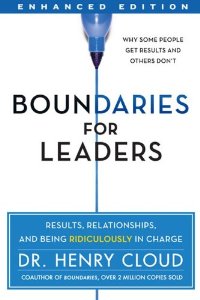 It was such a privilege to spend some time talking with Dr. Henry Cloud about Boundaries For Leaders: Results, Relationships and Being Ridiculously In Charge. In today’s interview, Dr. Cloud shares some great advice that will help you get unstuck.
It was such a privilege to spend some time talking with Dr. Henry Cloud about Boundaries For Leaders: Results, Relationships and Being Ridiculously In Charge. In today’s interview, Dr. Cloud shares some great advice that will help you get unstuck.
TONY: Why did you decide to write Boundaries for Leaders?
DR. CLOUD: Boundaries are basically about providing structure, and structure is essential in building anything that thrives. In my coaching and consulting work, I continued to see very gifted leaders who were not setting the essential boundaries that would have taken them to the next level, or would have turned struggling scenarios around. These boundaries are not difficult to establish, but they do take some proactive focus. I felt like a book that laid them out simply and clearly would be helpful.
TONY: How can an organization create a high performance senior leadership team that drives behaviors and leads results?
DR. CLOUD: It is essential that teams are organized by what I like to think of as “performance values.” These are the values of a team that load specifically on results. Then, they must define the behaviors that are going to bring those values to fruition and make covenants together to live those behaviors out and hold each other accountable. But the key is defining the right values. If a hospital, for example, wants to be known as the safest hospital in the city, then one value would be precision and zero mistakes. And there would be a lot of behaviors that could make that come true. There would be zero tolerance for risky behavior that could lead to a mistake. On the other hand, if a company’s mission depended on innovation, the last value they would want is one that required no mistakes and no risk. They would want to value the opposite, i.e. “make lots of mistakes,” and promise to step out and take risks, and then reward that. The values must be directly connected to the desired result and then teams should be built around behaviors that bring that to fruition.
TONY: Why is a leader without self-boundaries a dangerous threat to the vision of an organization?
DR. CLOUD: The higher one goes in leadership, he or she is leading others, but who is leading him or her? The highest leaders are the stewards of the vision and they are going to get what they “create or allow.” So, they must be in charge of themselves. Several self-boundaries are important but one in particular is the recognition of “patterns” in the organization and being in charge of oneself enough to step in and address those patterns when they occur. If the leader does not do that, those patterns become fixed in the DNA and identity of the organization and then the vision is in danger of being lost. The leader must watch the leader, as what happens to him or her becomes part of the organization.
TONY: How can an organization that is struggling to focus on what is important refocus and become more intentional about prioritizing time, money and staff on the right activities?
DR. CLOUD: There are a couple of things that are key here. First, go through a process of moving from key goals and objectives to defining what the teams that are going to drive those have to look like. Then make sure that the roles and responsibilities of the members of those teams are clearly aligned with the results. What roles and what responsibilities will it take to drive that result? Once you have done that, then define the activities that are the drivers of the results and get really serious about measuring the drivers in those specific roles. Get serious about accountability on the drivers, the activities that directly align with getting results. Define what people are in control of that direct line and then empower them to execute those things, measure them, and hold them accountable.
Pruning is also important here as well. Go through the three-step pruning process that I suggest that first involves pruning the “good things” that are taking resources away from the “best things.” Get serious about spending time and energy and money on the 20% of activities where the real life and future are. Get rid of the stuff that belongs to yesterday or is not where the real life of the enterprise is. Second, prune the stuff that is “sick and not going to get well.” Wave the white flag and let it go. Third, get real about the things that are already dead and are just taking up space. Just because someone is emotionally invested in them does not mean you should keep them.
TONY: Why do you think that the personal and interpersonal side of leadership is every bit as important as vision and execution?
DR. CLOUD: Let’s face it…. all of this stuff happens by, with and through people. It is the people side of it all that makes vision and execution happen. So, you must focus on who the people are, what they are doing, how they are doing it, and what you are doing to help them do it better. People are the energy that drive it all, and leaders must be bringing that energy to fruition in ways that is usable and effective. Leadership is about harnessing energy, and it takes good boundaries to make that happen.
______________________________________________
Dr. Henry Cloud is a leadership and organizational coach and consultant, and is the author of Boundaries For Leaders: Results, Relationships and Being Ridiculously In Charge. (HarperCollins, April 2013) For more information about Boundaries for Leaders and to join Dr. Cloud’s next simulcast, visit www.boundariesforleaders.com.







Leave a Reply